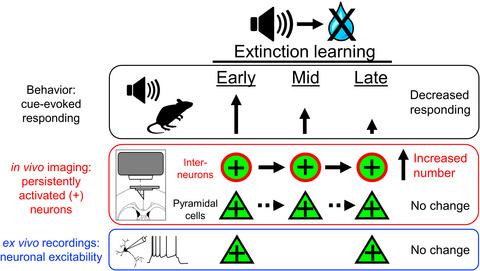当前位置:
X-MOL 学术
›
Eur. J. Nerosci.
›
论文详情
Our official English website, www.x-mol.net, welcomes your feedback! (Note: you will need to create a separate account there.)
Extinction of cue‐evoked food‐seeking recruits a GABAergic interneuron ensemble in the dorsal medial prefrontal cortex of mice
European Journal of Neroscience ( IF 3.4 ) Pub Date : 2020-05-11 , DOI: 10.1111/ejn.14754 Leonie S. Brebner 1 , Joseph J. Ziminski 1 , Gabriella Margetts‐Smith 1 , Meike C. Sieburg 1 , Catherine N. Hall 1 , Tristan G. Heintz 2 , Leon Lagnado 2 , Johannes Hirrlinger 3, 4 , Hans S. Crombag 1 , Eisuke Koya 1
European Journal of Neroscience ( IF 3.4 ) Pub Date : 2020-05-11 , DOI: 10.1111/ejn.14754 Leonie S. Brebner 1 , Joseph J. Ziminski 1 , Gabriella Margetts‐Smith 1 , Meike C. Sieburg 1 , Catherine N. Hall 1 , Tristan G. Heintz 2 , Leon Lagnado 2 , Johannes Hirrlinger 3, 4 , Hans S. Crombag 1 , Eisuke Koya 1
Affiliation

|
Animals must quickly adapt food‐seeking strategies to locate nutrient sources in dynamically changing environments. Learned associations between food and environmental cues that predict its availability promote food‐seeking behaviors. However, when such cues cease to predict food availability, animals undergo “extinction” learning, resulting in the inhibition of food‐seeking responses. Repeatedly activated sets of neurons, or “neuronal ensembles,” in the dorsal medial prefrontal cortex (dmPFC) are recruited following appetitive conditioning and undergo physiological adaptations thought to encode cue‐reward associations. However, little is known about how the recruitment and intrinsic excitability of such dmPFC ensembles are modulated by extinction learning. Here, we used in vivo 2‐Photon imaging in male Fos‐GFP mice that express green fluorescent protein (GFP) in recently behaviorally activated neurons to determine the recruitment of activated pyramidal and GABAergic interneuron dmPFC ensembles during extinction. During extinction, we revealed a persistent activation of a subset of interneurons which emerged from a wider population of interneurons activated during the initial extinction session. This activation pattern was not observed in pyramidal cells, and extinction learning did not modulate the excitability properties of activated pyramidal cells. Moreover, extinction learning reduced the likelihood of reactivation of pyramidal cells activated during the initial extinction session. Our findings illuminate novel neuronal activation patterns in the dmPFC underlying extinction of food‐seeking, and in particular, highlight an important role for interneuron ensembles in this inhibitory form of learning.
中文翻译:

提示性觅食的消亡在小鼠背内侧前额叶皮层中募集了GABA能中神经元集合
动物必须迅速适应寻求食物的策略,才能在动态变化的环境中找到营养来源。食物与环境线索之间的习得关联可以预测食物的可获得性,从而促进寻找食物的行为。但是,当这些提示不再能预测食物的可利用性时,动物就会进行“灭绝”学习,从而导致食物寻求反应受到抑制。在竞争条件下,募集了位于背部内侧前额叶皮层(dmPFC)中的反复激活的神经元集或“神经元集合”,并进行了生理适应性调节,以编码提示-奖励关联。但是,关于消光学习如何调节此类dmPFC集合体的募集和内在兴奋性知之甚少。在这里,我们在雄性Fos-GFP中使用了体内2光子成像在最近被行为激活的神经元中表达绿色荧光蛋白(GFP)的小鼠,以确定灭绝过程中激活的锥体和GABA能神经元dmPFC集合体的募集。在灭绝过程中,我们揭示了一个中间神经元子集的持续激活,这个子神经元是在初始灭绝过程中从更广泛的中间神经元群体中出现的。在锥体细胞中未观察到这种激活模式,并且灭绝学习并未调节激活的锥体细胞的兴奋性。此外,灭绝学习降低了在初始灭绝过程中激活的锥体细胞重新激活的可能性。我们的发现阐明了寻求食物绝种的dmPFC中新的神经元激活模式,特别是
更新日期:2020-05-11
中文翻译:

提示性觅食的消亡在小鼠背内侧前额叶皮层中募集了GABA能中神经元集合
动物必须迅速适应寻求食物的策略,才能在动态变化的环境中找到营养来源。食物与环境线索之间的习得关联可以预测食物的可获得性,从而促进寻找食物的行为。但是,当这些提示不再能预测食物的可利用性时,动物就会进行“灭绝”学习,从而导致食物寻求反应受到抑制。在竞争条件下,募集了位于背部内侧前额叶皮层(dmPFC)中的反复激活的神经元集或“神经元集合”,并进行了生理适应性调节,以编码提示-奖励关联。但是,关于消光学习如何调节此类dmPFC集合体的募集和内在兴奋性知之甚少。在这里,我们在雄性Fos-GFP中使用了体内2光子成像在最近被行为激活的神经元中表达绿色荧光蛋白(GFP)的小鼠,以确定灭绝过程中激活的锥体和GABA能神经元dmPFC集合体的募集。在灭绝过程中,我们揭示了一个中间神经元子集的持续激活,这个子神经元是在初始灭绝过程中从更广泛的中间神经元群体中出现的。在锥体细胞中未观察到这种激活模式,并且灭绝学习并未调节激活的锥体细胞的兴奋性。此外,灭绝学习降低了在初始灭绝过程中激活的锥体细胞重新激活的可能性。我们的发现阐明了寻求食物绝种的dmPFC中新的神经元激活模式,特别是



























 京公网安备 11010802027423号
京公网安备 11010802027423号